Think you’re in the middle of zipping a file, and an unexpected message occurs on your screen: “File not found or no read permission.” It turns out to be a sudden roadblock that only disrupts your momentum but demands immediate attention. Anyway, it indicates that your system is unable to locate or access the required resources, leaving you with an uncompressed file/folder.
This rising confusion makes you wonder what the reason could be behind this error and what measures should be taken to resolve it. For your assistance, the following article provides a comprehensive solution, covering everything from the reasons behind this issue to workable solutions. You're further guided with detailed, stepwise tutorials for each solution, allowing you to learn and perform on your own.
In this article
Part 1. Understanding the Reasons Behind "File Not Found or No Read Permissions" Error
Go through the entire section to understand the valuable reasons behind the "file not found or no read permission” error:
Not Correct File Path: This error mostly occurs when a file has been removed or renamed, without updating the path reference. Thus, trying to access a document from the desktop shortcut that points to a now deleted or relocated file results in this system error.
Read Permission: Although the file may be present in your system, you may get this error when your user account does not have permission to read the file. It mainly happens in shared computing, where administrative settings restrict access to sensitive folders or files.
Files are Broken or Damaged: Whenever an unzipped file becomes corrupted, its internal structures become unreadable, resulting in the system treating it as nonexistent. Even if a file appears in the folder, trying to open it may activate this error because the system can’t process the damaged content.
External Drive Associated Issues: When you’re attempting to access a file stored on an external hard drive, the error might be due to connection problems. Conversely, the system might fail to recognize the external device due to outdated drivers or file system errors, making files appear missing.
Security Restrictions on Files: At certain times, security platforms such as antivirus software or a firewall mistakenly flag legitimate files as threats. In such moments, the file may still be present but is actively shielded from user access by the security system, leading to this issue.
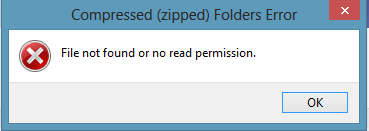
Part 2. 7 Ways to Resolve "File Not Found or No Read Permissions" Issue
This “file not found or no read permission” might seem complex, but the provided solutions ensure you’re sorted in no time:
Way 1. Create New User Account
A restricted account can periodically interrupt file access, activating the error, even when the file is fully intact. Here, the new user profile acts as a clean slate, which is free from inherited issues or restrictions blocking folder zipping. When you’re able to open a file under a new account, it shows that your original user profile was the cause. Adhere to the tutorial and learn how to create a new user account:
Step 1. Visit “Control Panel” on your desktop and click the “Change Account Type” option provided under “User Account.”
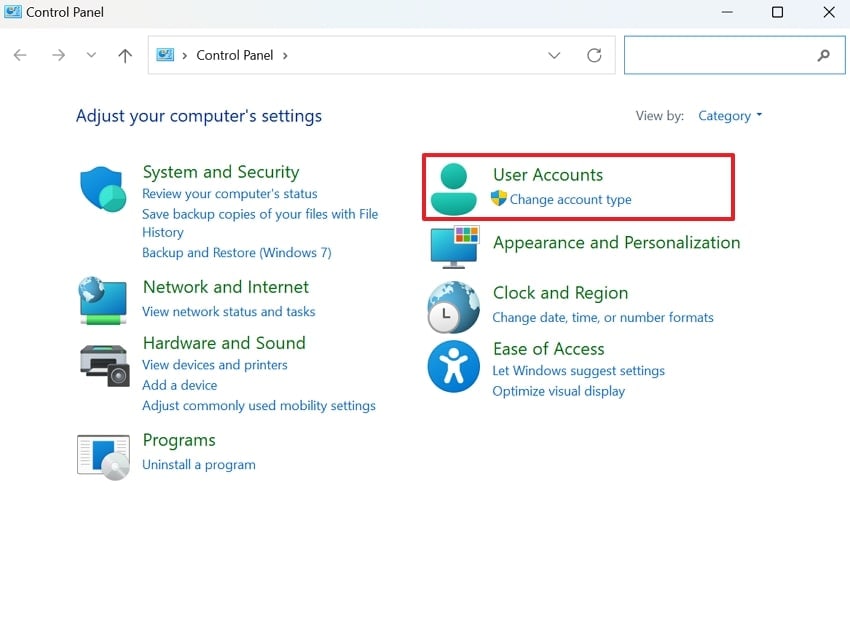
Step 2. From the Manage Account window, press the “Add a New User in PC Settings” option to create a new account.
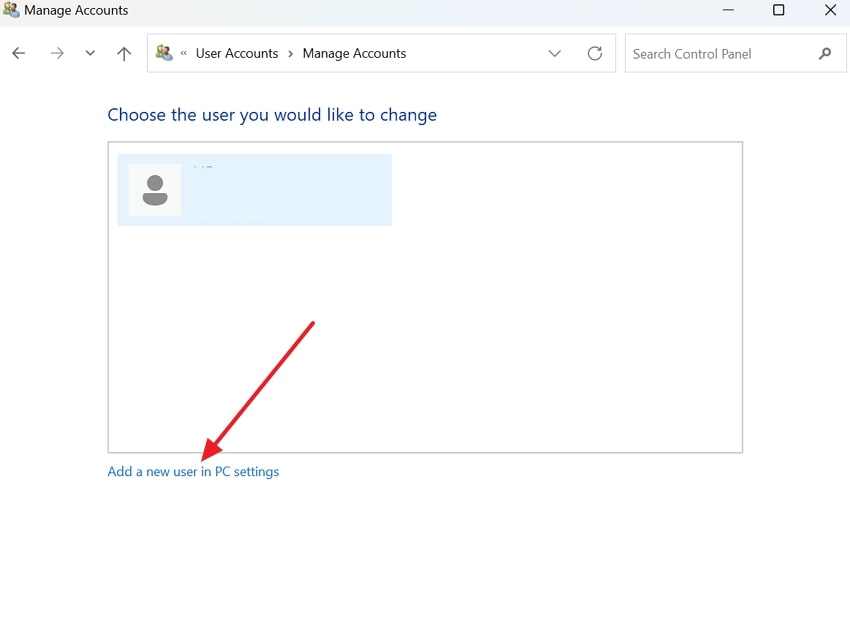
Step 3. Following this, you'll be navigated to the "Other Users” window, where you’ll need to press the “Add Account” button.
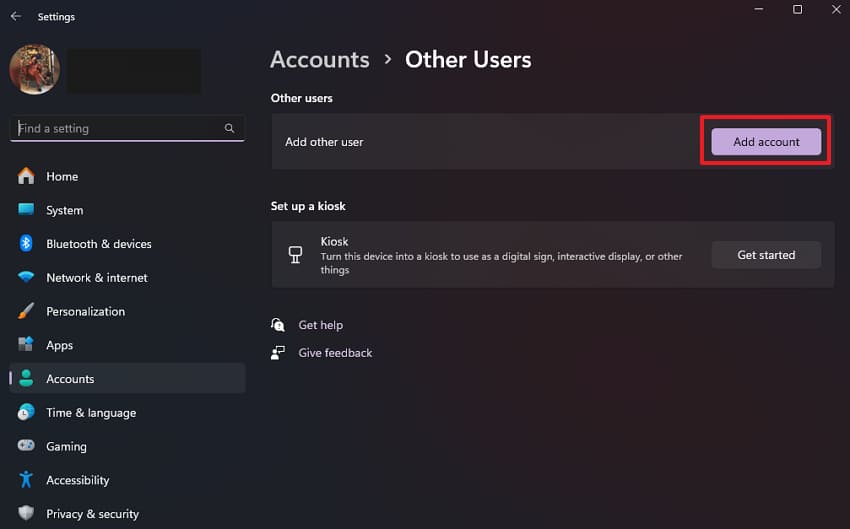
Step 4. Enter the email address to create a Microsoft account and press the “Next” button once done. Next, follow the on-screen instructions and click the “Change Account Type” to set it to administrator type. In the end, sign in to your recently created user account and try re-accessing the file.
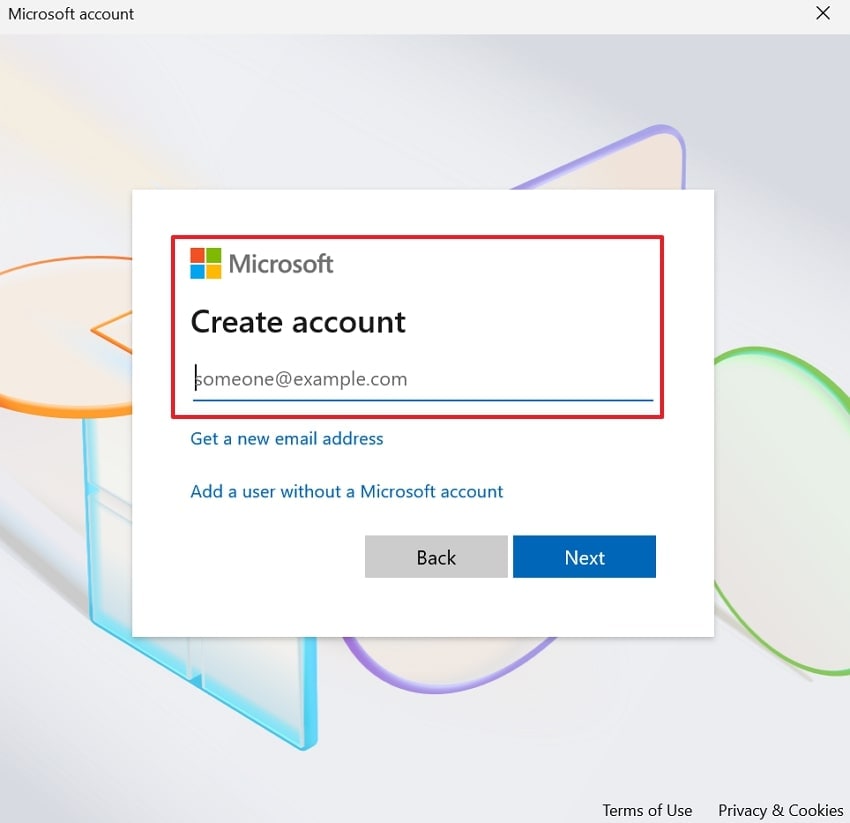
Way 2. Failed to Open Damaged File? Use Repairit and Make It Openable Now!
When you have a file that refuses to open, no matter what you do, the issue is at the fundamental level. To do this, Repairit is an innovative method to recover all the minute details and covers over 30 file formats. It does not matter whether you have a file not found or no read permission error, or any other corruption state; you are good to go with no loss of data.
Besides, multiple files can be repaired simultaneously, irrespective of the format and size of the files. When you're done repairing, it even allows you to view your repaired files for better analysis before saving. The program looks after text, hyperlinks, forms, and even graphs in your PDF files. Possibilities are unlimited, such as users can repair their PPT/PPTX files without modifying the original files.
Key Features
Fixes Unreadable Documents: This software repairs files that are completely corrupted and whose data isn't readable or accessible anymore.
Restores Garbled Files: When the stored information isn’t clear and has been distorted, Repairit addresses this issue while restoring the missing header and details.
Mends Files with Changed Layouts: Through this repair program, you can restore the overall layout and appearance of a document with precision.

-
Fixes Unreadable Documents: This software repairs files that are completely corrupted and whose data isn't readable or accessible anymore.
-
Restores Garbled Files: When the stored information isn’t clear and has been distorted, Repairit addresses this issue while restoring the missing header and details.
-
Mends Files with Changed Layouts: Through this repair program, you can restore the overall layout and appearance of a document with precision.
A Detailed Manual to Repair Damaged Files Through Repairit
When your file starts throwing errors like, file not found or no read permission, head to the provided step-by-step manual:
Step 1. Commence the Software and Enter Document Repair Portion
For this, install the program and gain access to the "More Type Repair” tab from the left-hand panel. Now, choose the “Document Repair” module and press the “Start" button to proceed.
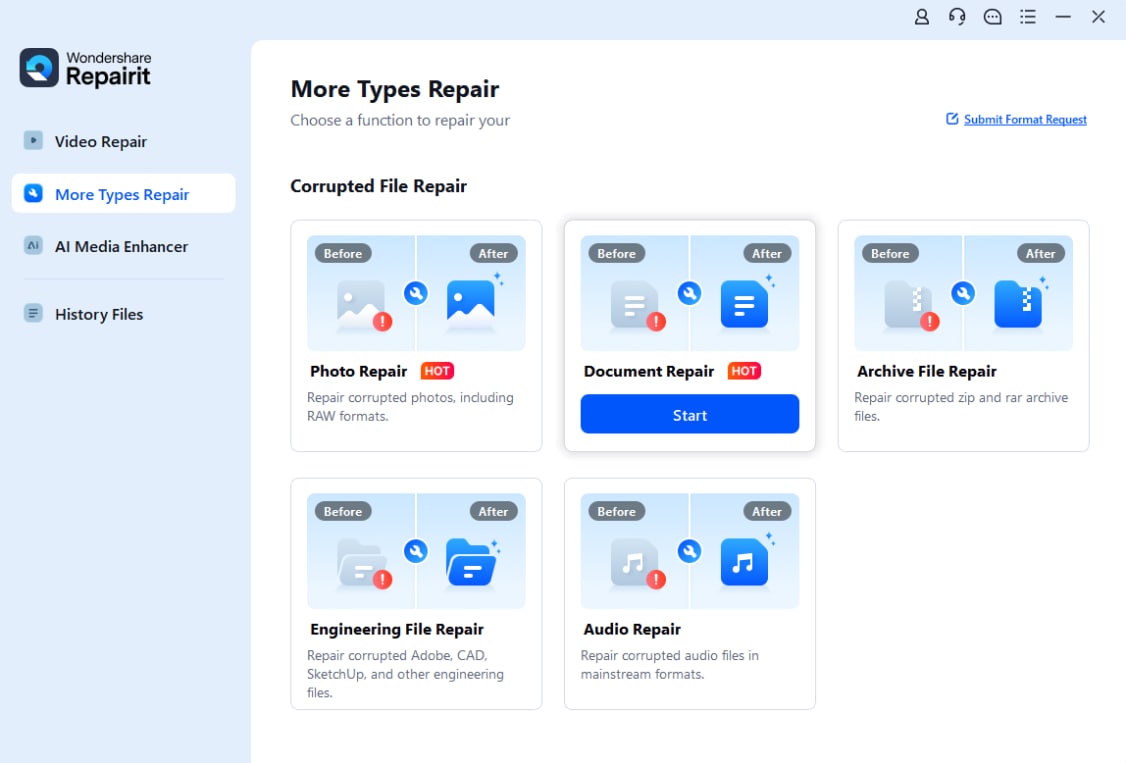
Step 2. Insert All the Broken Documents for Repair
Move forward and click the “+Add” button to insert all the corrupted files at once for an instant fixing process.
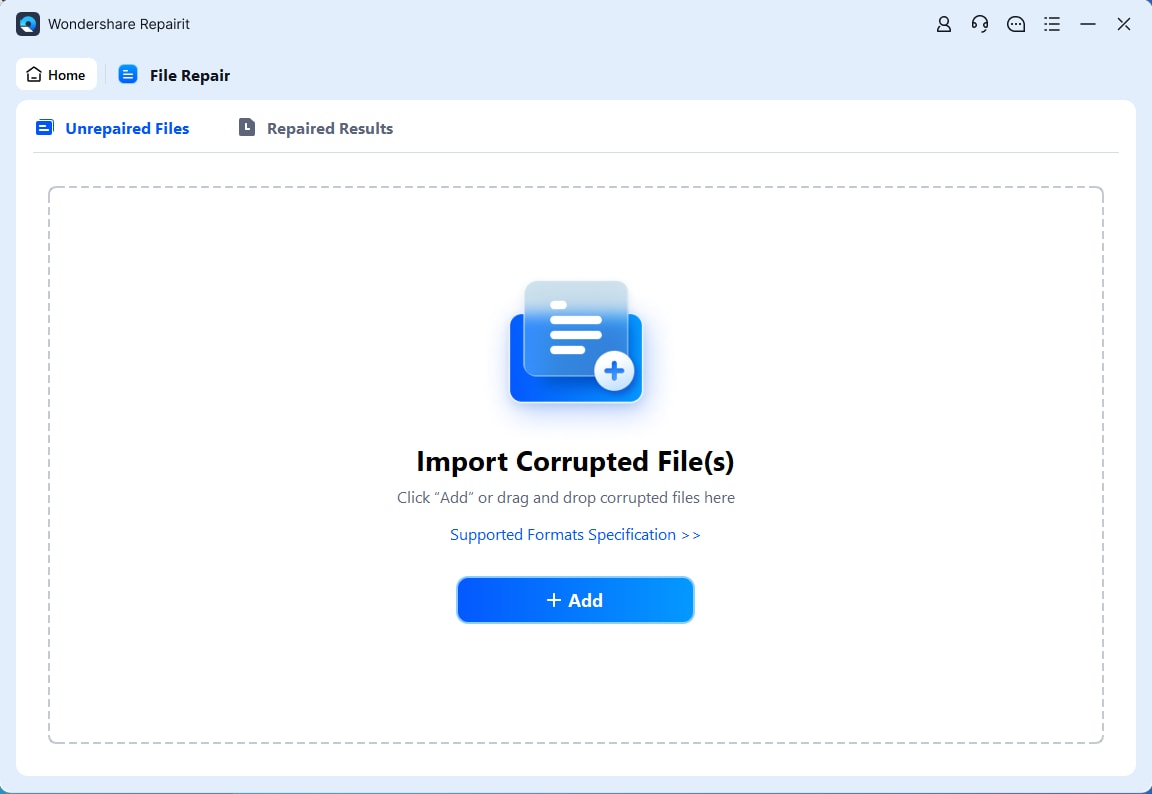
Step 3. Initiate the Repair Process and Save Files After Repair
When you’re done adding, navigate to the “Repair” button to fix all the added corrupted files. Once the repair action finishes, preview your repaired files and save them on your device for later use.

Repair "File Not Found or No Read Permissions" Error

Way 3. Obtain Required Permissions
As explained, in case a user account lacks the required permissions, Windows will prevent access to files. By updating the file manually, one gets to have control over file access; therefore, the error of file not found, or no read permission, is eliminated. When you assign Read or Full Control rights to yourself, it even erases unnecessary barriers and provides long-term access. Explore these instructions and know how to do it yourself:
Step 1. To do this, navigate to the inaccessible file and right-click it to select the “Properties” option from the drop-down menu. After this, access the “Security” tab and proceed to the “Edit” button to obtain permissions later.
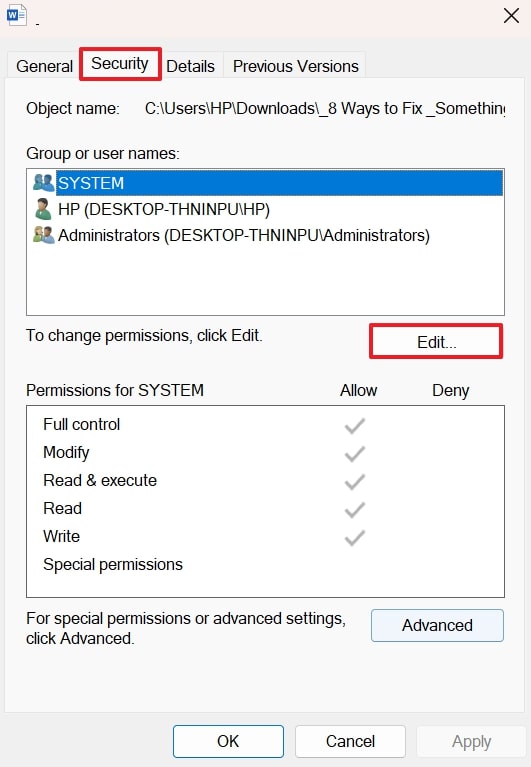
Step 2. Now, under the “Group or User Names” section, choose a username or press the “Add” button to enter another.
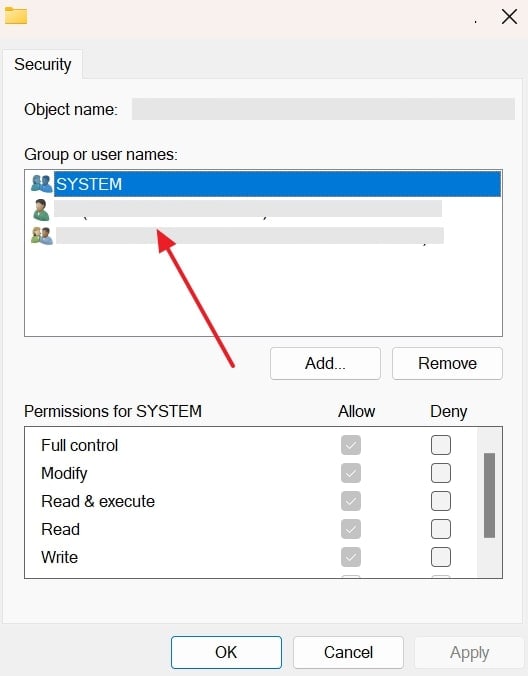
Step 3. Move forward and check boxes under the “Allow” section to grant permissions to your chosen username. Once done, press the “Apply" button first and then the "OK” button to confirm or save the changes.
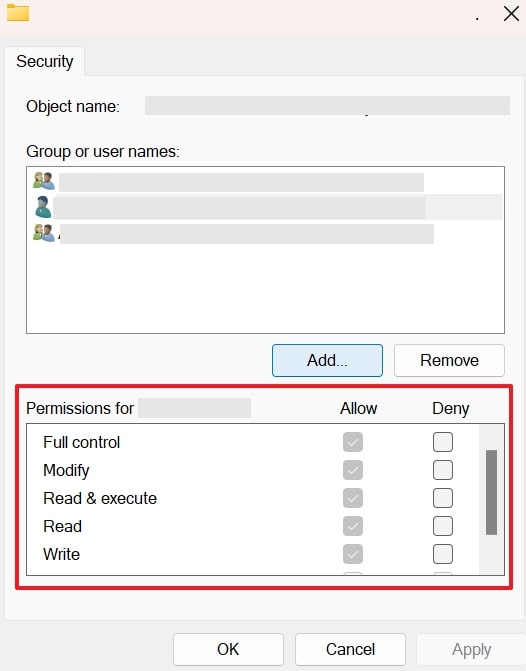
Way 4. Ensure the File Path is Accurate
A " file not found or no read permission" error may be caused by an incorrect file path, as it is the primary one that is frequently ignored. By fixing the file path, this ensures that your system checks where it is supposed to and eliminates the confusion. Besides, it improves file tracking, minimizing the dependencies on outdated shortcuts or broken links. For better understanding, read the provided instructions and get sorted:
Instructions: For this, gain access to your “File Manager” and locate the file or folder making trouble with access. Now, right-click it to select the “Open File Location” option from the menu and verify the actual path. Following this, if you’re directed to a missing or wrong location, delete it and create a new one using the correct path.
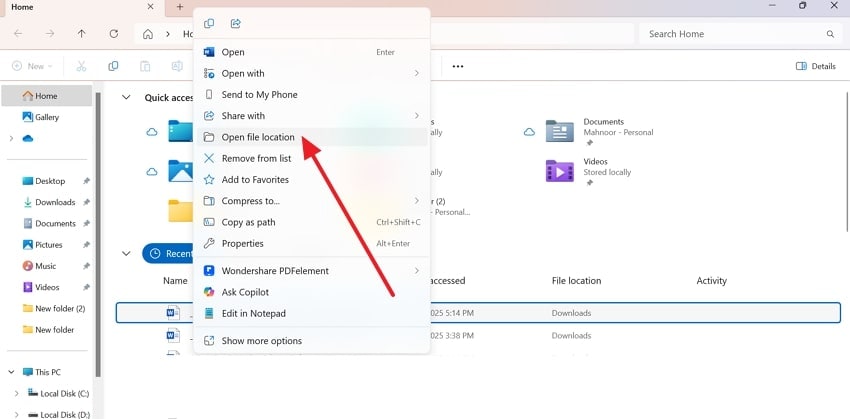
Way 5. Restart Your Computer
It might sound like basic, but sometimes, a simple system reboot does wonders for issues like file not found or no read permission. A complete restart in this situation clears the system memory, resets active processes, and even releases any file locks. This can resolve any hidden issues that are not immediately visible but are resulting in a “file not found” error. Follow simple instructions to know how to restart your computer:
Instructions: Proceed to the “Start” button on your Windows and press the “Power” button in the bottom right corner. From the revealing menu, select the “Restart” option to allow the system to reboot and resolve recurring errors fully.
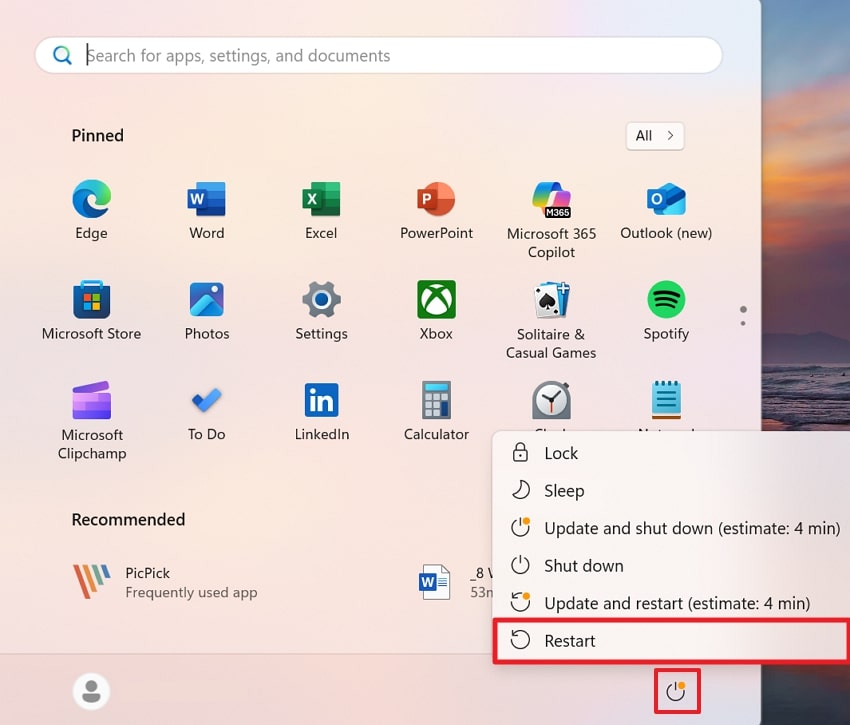
Way 6. Check If Other Processes Are Using the File
The files might be actively open or in use by other applications, locking the system with no other process or access. This might lead to files not found or no read permission, even when the file exists, and your access rights are valid. To resolve conflicts, you should free up the files by ending the process that’s hindering access. The provided instructions better explain how to proceed with it:
Instructions: Gain entrance to “Task Manager” on your Windows and navigate to the “Processes” tab from the left-hand side. Now, find any open application that might be using the file and right-click it to choose the “End Task" option. After this, wait for a few seconds to ensure the system releases the lock, and later try re-accessing the file.
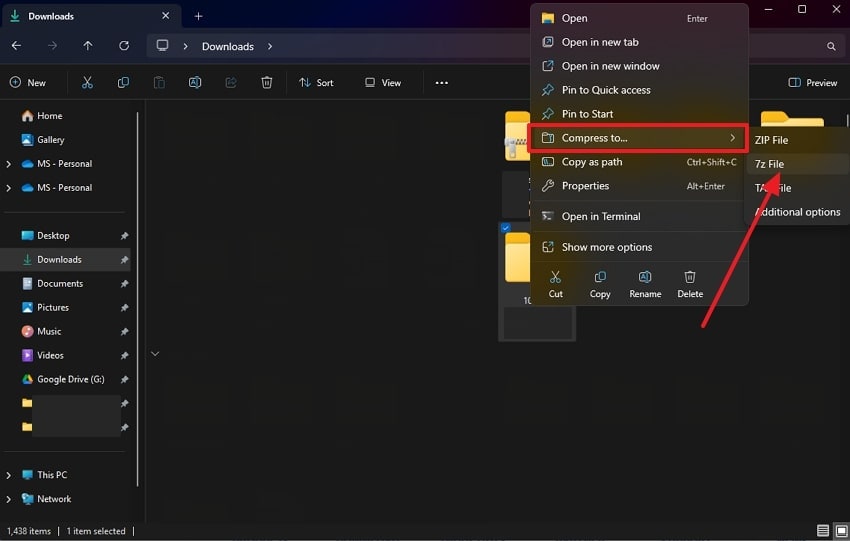
Way 7. Use Third-Party Software
In case you’re facing a persistent “file not found or no read permission" error, third-party tools can offer a workable workaround. Here, programs like WinRAR not only create and unpack ZIP but also provide features to bypass certain permission issues. Besides, it's compatible with Windows 10,11, and other operating systems, providing a well-organized data storage option. Learn how to compress and unpack your ZIP files, explore the provided tutorial:
Instructions. To compress first, locate the file in your “File Manager" and right-click it to choose the "Compress To” option from the menu. After this, select the “7z File” option or go to the WinRAR menu to compress your file automatically.

Conclusion
To sum it up, this file not found, or no read permission error, may derail your whole workflow, no matter what the cause. Luckily, the mistake is easily correctable, and with some simple knowledge, you can recover and retrieve those files once more. Anyway, if the error indicates corruption, consider Repairit as a comprehensive solution for all sorts of file damage.
FAQ
-
Q1. Can this error happen after updating Windows?
Definitely, soon after a major Windows update, some system settings, including file permissions, may be reset or changed. This ultimately affects access to certain files or folders, especially when they were previously stored in protected directories. -
Q2. Should I consider restoring my system if nothing else works?
For a recurring “file not found or no read permission” issue, if everything else fails, you may consider using System Restore to revert your PC. This will eventually resolve any hidden configuration problem without affecting your personal files. -
Q3. Can file compression or encryption cause this error?
In some cases, when a file is compressed or encrypted, your computer might fail to read it, and a permission-related error will occur. To solve this problem, you may have to decrypt the file or assume ownership before you can access it. In addition, ensure that the original encryption certificate or password is still in place.

![[Solved] File Not Found or No Read Permissions Error on PC](https://images.wondershare.com/repairit/article-trans-image/1354/file-not-found-or-no-read-permission-1.jpg)
 ChatGPT
ChatGPT
 Perplexity
Perplexity
 Google AI Mode
Google AI Mode
 Grok
Grok

